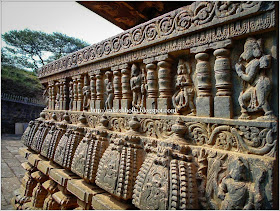This
large temple has a big mandapa which is open for entrance from three sides.
This large mandapa is connected with a small hall or navaranga through a porch.
Navaranga is also entered from three sides, east, south and north. Low parapet
wall runs on all sides of the outer large mandapa. On this well are provided
numerous mini-shirnes with Nagara tower. Above these shrines are miniature
images often describing some story such as Vishnu’s Trivikrama episode. Inside
the hall, runs a stone bench on all sides.
Many of these miniature images are chiselled off by Muslim when the
temple served as a mosque during the occupation of the Bijapur army. However,
what remains depict the genius of the artists and their imagination. There are
two beautiful arabesque windows, one on each side of the entrance of the inner
hall. Both of these windows are damaged leaving only few jagged frames.
The
doorway of the hall is also devoid of its various images during the Muslim
rule. I realized that the
important face is the Kirttimukha’s (lion-face) with bulging eyes that appears
everywhere. The word Kirttimukha means
glorious face for various reasons which we won’t get into here. It is not an
ordinary face of a lion, the faces usually portrayed with bulging eyes with two
strands emerging from its mouth. In some interpretations this is the face of a
monster swallowing its tail following Shiva's order so that it was finally
left with its face.
If the monotheistic god of Islam or Jews brooks little tolerance for other
gods, our infinite-theistic approach can brook intolerance and come out
unperturbed absorbing al destruction and coming out in a new creation. That is
what Bankapur teaches us. The secular snakes in could be the past and the
future.
HISTORY- What is historically interesting about this for site is that it
has had several levels of rulers who date back at least to the 5th century AD
and to earlier times. The earliest known reference of Bankapur is
found in a Kolhapur Jain manuscript, dated 898 CE, where it is mentioned that
the great city of Bankapur was named after the Chellaketan chief Bankeyaras who
was a feudatory of Rashtrakuta king Amoghavarsha I. The above might be true as
it is evident from inscriptions that Rashtrakutas would have ruled over it.
Bankapur served as the capital
of the Rashtrakuta king Indra-Vallabha as found in an inscription from Boganur
in the Navalgund Taluk. Bankapur would have been an important town associated
with Jainism. Inscriptions found here mention as Jain temple patronized by the
ruling chiefs. Five different Jain schools were established at the town during
that time as evident from inscription. Western Ganga kings are known for their
patronage towards Jainism this all suggests that Bankapur was an important Jain
centre during ninth-tenth century CE.Bankapur was also famous as a Kalamukha center. Nagreshwar temple inscription talks about land grants given to a Kalamukha priest, Vimalashakti. Shakti in his name suggests that he might have belonged to the Shakti-parishad branch of Kalamukha sect. It is not strange to find Kalamukhas vestiges in Bankapur. Gadag and Haveri, both near Bankapur, were very important Kalamukha centres in the past. After the Rashtrakutas, Bankapur being situated under Panungal-500 (modern Hangal) came under the Hangal Kadamba chiefs. They ruled as the feudatory chiefs under the Western Chalukyas. After the fall of Western Chalukyas, it was ruled by Suenas and Hoysalas. After the Hoysalas, the town came under the Muslim rule before moving into the Vijayanagara kingdom.
The third Bahmani king,
Mujahid Shah (1375-78 CE), demanded Bankapur fort from the Vijayanagara king
Bukka (1356-1377 CE), but the latter did not give up. In 1406, the eighth
Bahmani king, Sultan Feroze Shah (1397-1422 CE), took over Bankapur from
Vijayanagara king Deva Raya I (1406-1422 CE) getting about 60,000 Hindu
prisoners. Deva Raya ceded for peace, giving his daughter in marriage and the
Bankapur fort to the Sultan. Bankapur played a very important role in Krishna
Deva Raya’s battle with Sultan of Bijapur. Krishna Deva had almost the entire
south under his sway. He was anxious to secure horses for his troops. Bankapur
was on the way from Goa to Vijayanagara.
In 1512 CE, Bankapur chief
sent a congratulation message to Portuguese on Afonso de Albuquerque’s capture
of Goa. He also asked for permission to import three-hundred horses a year. The
request was granted. It was necessary for the Bankapur chief to be on cordial
relationship with Portuguese so that horses can be obtained. This political
settlement was very beneficial for Krishna Deva Raya.In 1573, Ali Adil Shah of Bijapur moved against Dharwad and Bankapur. Bankapur, under his chief Velappa Ray, defended bravely the fort for one year and three months. But he had to surrender at last to Adil Shah as he did not get help from his masters. Firishtah mentions that Adil Shah destroyed a superb temple inside the fort and himself laid the first stone of a mosque which was built on temple’s foundation. In 1673, Abdul Karim Khan, of the line of the Savanur Nawabs, was appointed governor of the province of Bankapur under the patronage of Bijapur. In 1747, Nawab of Savanur made a treaty with the Marathas in which he gave up all his land keeping Bankapur, Hangal, Hubli to himself. In 1755, Savanur was besieged by French general Bussy. To save Savanur, the Nawab pledged the Bankapur fort to the Holkars. In 1776, Hyder Ali took over Bankapur and Savanur. In 1780, Tipu Sultan celebrated Muharram in Bankapur. In 1802, Bankapur was ceded to British by Peshwa. These were restored to him in 1803 in exchange of Bundelkhand.
.jpg)
.jpg)
.jpg)
.jpg)
.jpg)
.jpg)
.jpg)
.jpg)
.jpg)
.jpg)
.jpg)
.jpg)
.jpg)
.jpg)
.jpg)
.jpg)
.jpg)
.jpg)
.jpg)
.jpg)
Nice to know about this temple. Such a gorgeous one with magnificent sculptures.
ReplyDelete